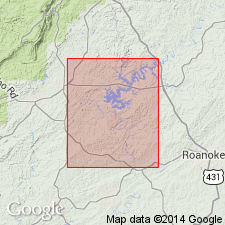
- Usage in publication:
-
- Emuckfaw Formation
- Modifications:
-
- Named
- Dominant lithology:
-
- Schist
- Gneiss
- AAPG geologic province:
-
- Piedmont-Blue Ridge province
Summary:
Emuckfaw Formation here named for exposures along Emuckfaw Creek, Tallapoosa Co., AL. Unit includes the Roopville facies and the Centralhatchee facies of Bentley and Neathery (1970) in AL. (Roopville, Glenloch, and Centralhatchee are Formations in the Heard Group of GA.) The Emuckfaw is an interlayered sequence of schist and gneiss. The schist is generally medium-grained, composed of muscovite, feldspar, and quartz. The gneiss is fine-grained and composed of muscovite, biotite, feldspar, and quartz with accessory kyanite, ilmenite, and magnetite. Contains garnets throughout, as large as 2 cm along the southeastern side of the Alexander City fault, but generally 1 mm or less. Weathers to a characteristic white, sandy, muscovite-rich soil in most of its outcrop area. Lies to the southwest of the Wedowee Group. Overlies Kowaliga Augen Gneiss. Intruded by Zana Granite. Age is Paleozoic.
Source: GNU records (USGS DDS-6; Reston GNULEX).
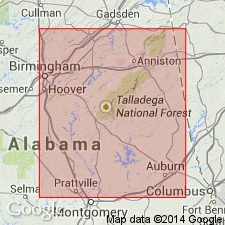
- Usage in publication:
-
- Emuckfaw Formation
- Modifications:
-
- Areal extent
- AAPG geologic province:
-
- Piedmont-Blue Ridge province
Summary:
The Emuckfaw Formation forms the southeastern belt of the Tallapoosa block and was originally mapped by Adams (1926) as part of the Ashland Mica Schist. Although this sequence is similar to the Ashland Supergroup in the Coosa block, particularly in its abundance of amphibolites, no direct continuity between the two units has been shown. The Emuckfaw apparently continues through Georgia into North Carolina where it is correlated with the Ashe Formation.
Source: GNU records (USGS DDS-6; Reston GNULEX).
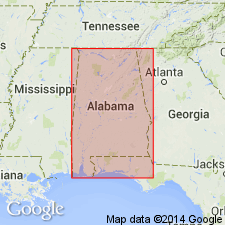
- Usage in publication:
-
- Emuckfaw Formation
- Modifications:
-
- Revised
- AAPG geologic province:
-
- Piedmont-Blue Ridge province
Summary:
Emuckfaw Formation informally subdivided by Bieler and Deininger (1984, Geological Society of America, Abstracts with Programs, v. 16) into lower garnet-bearing Josie Leg member and upper garnet-free Timbergut member. Emuckfaw is equivalent to Heard Group. Age is early Paleozoic(?).
Source: GNU records (USGS DDS-6; Reston GNULEX).
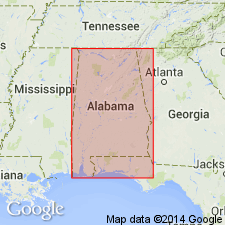
- Usage in publication:
-
- Emuckfaw Group
- Modifications:
-
- Overview
- AAPG geologic province:
-
- Piedmont-Blue Ridge province
Summary:
Emuckfaw Group is a sequence of medium-grained muscovite-biotite-feldspar schist, fine-grained muscovite-biotite-quartz-feldspar gneiss, graphite-garnet-muscovite schist, and quartzite with occasional thin amphibolite and rare ultramafic pods. May include thin aluminous graphitic schists. Locally sheared to mylonite schist. Includes Glenloch Schist.
Source: GNU records (USGS DDS-6; Reston GNULEX).
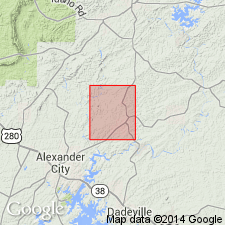
- Usage in publication:
-
- Emuckfaw Group
- Modifications:
-
- Revised
- AAPG geologic province:
-
- Piedmont-Blue Ridge province
Summary:
Emuckfaw is elevated to group status because of its lithologic diversity and areal extent. Informal Josie Leg and Timbergut members are upgraded to formation status, but remain informal. Formal proposals are forthcoming by Bieler and Guthrie. Josie Leg consists of an interlayered sequence of garnet biotite muscovite quartz schist, garnet biotite plagioclase gneiss and thin-bedded amphibolite. Also includes a distinctive, greenish-gray garnet quartzite here informally referred to as the Perryville quartzite member. Overlying Timbergut formation is a heterogeneous assemblage of schist and gneiss characterized by a noticeable lack of garnet and feldspar and a greater percentage of muscovite than biotite. In the study area includes minor amounts of calc-silicate gneiss and amphibolite. Schists are dominant over gneisses. The two formations are separated by intensely sheared granite gneiss, here assigned to the Zana Granite. Josie Leg corresponds to the northern Heard Group, while Timbergut corresponds to the southern Heard Group, as defined by Muangnoicharoen (1975). Therefore, Heard Group should be abandoned. Emuckfaw overlies Wedowee Group. Upper age constraint of Middle Ordovician concluded from premetamorphic intrusion of Zana Granite.
Source: GNU records (USGS DDS-6; Reston GNULEX).
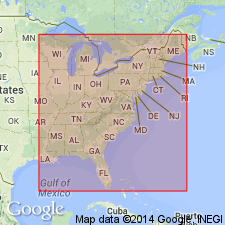
- Usage in publication:
-
- Emuckfaw Formation
- Modifications:
-
- Overview
- AAPG geologic province:
-
- Piedmont-Blue Ridge province
Summary:
Sandy Springs Group of McConnell and Abrams (1984) west of Atlanta, GA, appears to be continuous into AL with Emuckfaw Formation of Neathery and Reynolds (1975).
Source: GNU records (USGS DDS-6; Reston GNULEX).
For more information, please contact Nancy Stamm, Geologic Names Committee Secretary.
Asterisk (*) indicates published by U.S. Geological Survey authors.
"No current usage" (†) implies that a name has been abandoned or has fallen into disuse. Former usage and, if known, replacement name given in parentheses ( ).
Slash (/) indicates name conflicts with nomenclatural guidelines (CSN, 1933; ACSN, 1961, 1970; NACSN, 1983, 2005, 2021). May be explained within brackets ([ ]).

